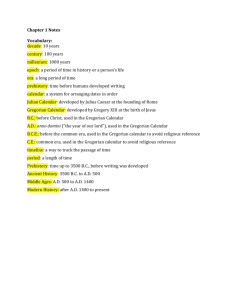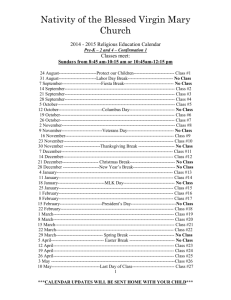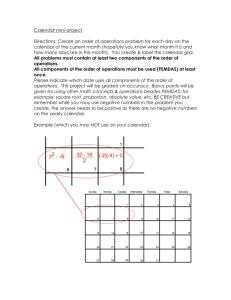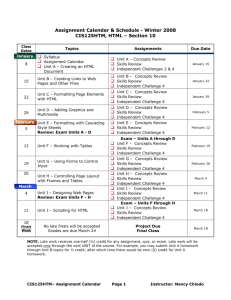julian calendar
advertisement
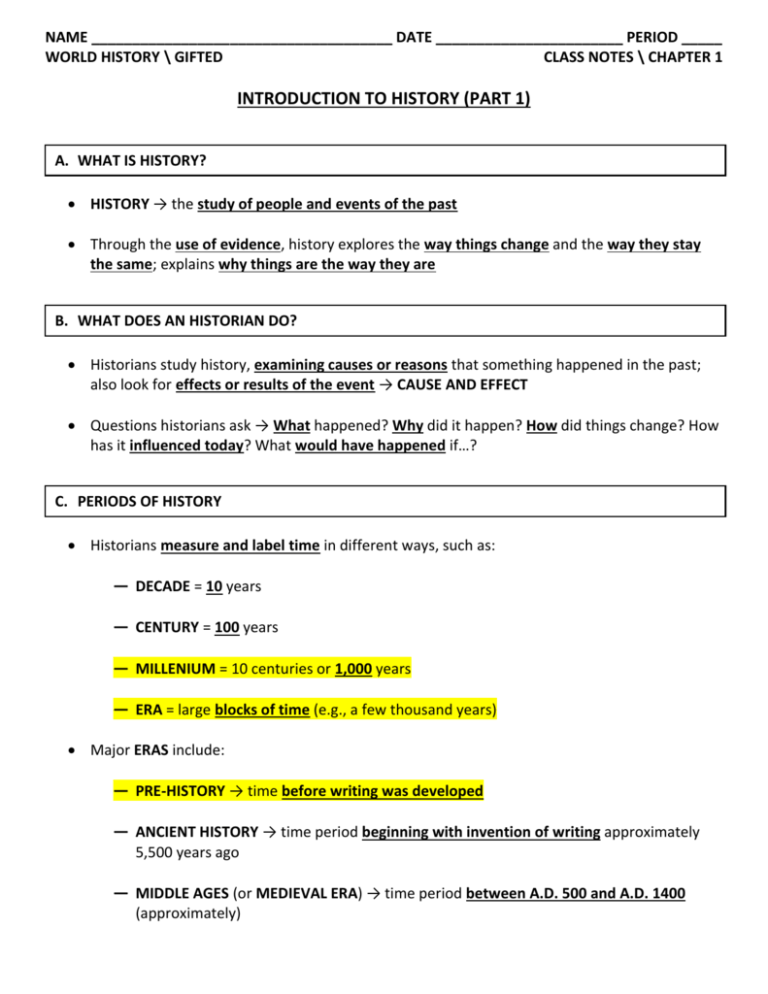
NAME _____________________________________ DATE _______________________ PERIOD _____ WORLD HISTORY \ GIFTED CLASS NOTES \ CHAPTER 1 INTRODUCTION TO HISTORY (PART 1) A. WHAT IS HISTORY? HISTORY → the study of people and events of the past Through the use of evidence, history explores the way things change and the way they stay the same; explains why things are the way they are B. WHAT DOES AN HISTORIAN DO? Historians study history, examining causes or reasons that something happened in the past; also look for effects or results of the event → CAUSE AND EFFECT Questions historians ask → What happened? Why did it happen? How did things change? How has it influenced today? What would have happened if…? C. PERIODS OF HISTORY Historians measure and label time in different ways, such as: — DECADE = 10 years — CENTURY = 100 years — MILLENIUM = 10 centuries or 1,000 years — ERA = large blocks of time (e.g., a few thousand years) Major ERAS include: — PRE-HISTORY → time before writing was developed — ANCIENT HISTORY → time period beginning with invention of writing approximately 5,500 years ago — MIDDLE AGES (or MEDIEVAL ERA) → time period between A.D. 500 and A.D. 1400 (approximately) — MODERN HISTORY → time period beginning about A.D. 1400 through present day — Example American Revolution D. CALENDARS CALENDAR → system for arranging days in order; approximately 40 different calendars have been developed by cultures around the world JULIAN CALENDAR → calendar developed by Roman general and statesman JULIUS CAESAR in 46 B.C.; used through A.D. 1582 — Julian calendar divided year into 12 months that alternated from 30 to 31 days, except February, which had 28 → every four years, however, February was 29 days long — Julian calendar was approximately 11 minutes out of sync with solar year SOLAR YEAR = length of time for earth to complete one revolution around sun, or 365 DAYS, 5 HOURS, and 48 MINUTES) GREGORIAN CALENDAR → calendar IN USE TODAY in almost all of the world; all modern business (worldwide) uses its dates — POPE GREGORY XIII (catholic pope) established calendar in 1582 → purpose was to correct Julian calendar, which was off by approximately 10 days at the time — Like Julian calendar, Gregorian calendar accounts for additional ¼ of a day (approximately six hours) of solar year by adding one day to February every four years → LEAP YEAR — Because Julian calendar was out of sync with solar year by 11 minutes, Gregorian calendar featured following adjustment: Years marking a century (e.g., 1700, 1800, 1900) would NOT BE LEAP YEARS unless divisible by 400 (e.g., 1600, 2000) — Gregorian calendar begins counting with birth of Jesus (YEAR ONE); years before and after birth of Christ are denoted as follows: B.C. = “Before Christ” A.D. = “Anno Domini” (“In the Year of Our Lord”) — Gregorian calendar features no YEAR ZERO → year before A.D. 1 is 1 B.C. To date events BEFORE birth of Christ, historians count BACKWARDS; to date events AFTER birth of Christ, historians count FORWARDS 435 BC 185 BC AD 225 AD 555 (example of Chronological order) — Historians who prefer to avoid religious references with regard to calendar use the following: B.C.E. = “Before Common Era” (replaces B.C.) C.E. = “Common Era” (replaced A.D.) — Although most of the world uses Gregorian calendar, some cultures maintain their own (e.g., Jewish calendar begins in year 3760 B.C.; Muslim calendar begins in year A.D. 622) E. TIMELINES TIMELINES → another method of tracking passage of time; show order of events within a period of time and amount of time between events; help make sense of events Dates on a timeline are usually evenly spaced; if a timeline covers too much time, a jagged line might be placed to show that a certain period of time was omitted (kept out) F. STUDYING EARLY HISTORY Much of the study of early history, particularly pre-history, involves use of science to examine PHYSICAL EVIDENCE left behind by our ancestors — PALEONTOLOGY → study of fossils of animals, plants, and other organisms to learn what world was like in pre-historic times (more than 5,500 years ago) FOSSILS = remains of plant and animal life buried and preserved in earth or rock Fossil record shows that living things formed and developed over time through EVOLUTION — ARCHAEOLOGY → study of the remains (i.e., what’s been left behind) of past human cultures Archaeology is chief method available for learning about societies that existed BEFORE INVENTION OF WRITING about 5,500 years ago; also adds to our knowledge of ancient societies that left WRITTEN RECORDS Archaeologists excavate (i.e., dig) earth in places where people once lived → they study ARTIFACTS to learn what life was like in the past, while also examining disturbances (i.e., changes) to natural surroundings to indicate type of activities human engaged in ARTIFACTS = objects made by people (e.g., pottery, tools, weapons, jewelry) for a particular purpose and from a particular period of time Archaeologists also examine why major changes occurred in certain cultures → e.g., why ancient people stopped hunting and started farming — ANTHROPOLOGY = study of humankind, past and present; more specifically, study of human CULTURE, or strategies that people learn(ed) and share(d) as members of a society or social group Archaeology is considered a branch of anthropology G. ORIGINS OF HUMANS Scientists believe HUMANS (HOMO SAPIENS) developed 150,000 to 195,000 years ago HOMO SAPIENS = “WISE MAN” Oldest fossils discovered of ANCESTORS TO HUMANS are those of hominids (humanlike creatures) given the names ARDI (4.4 million years old) and LUCY (3.2 million years old)


